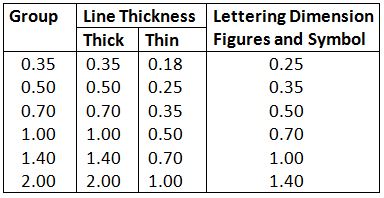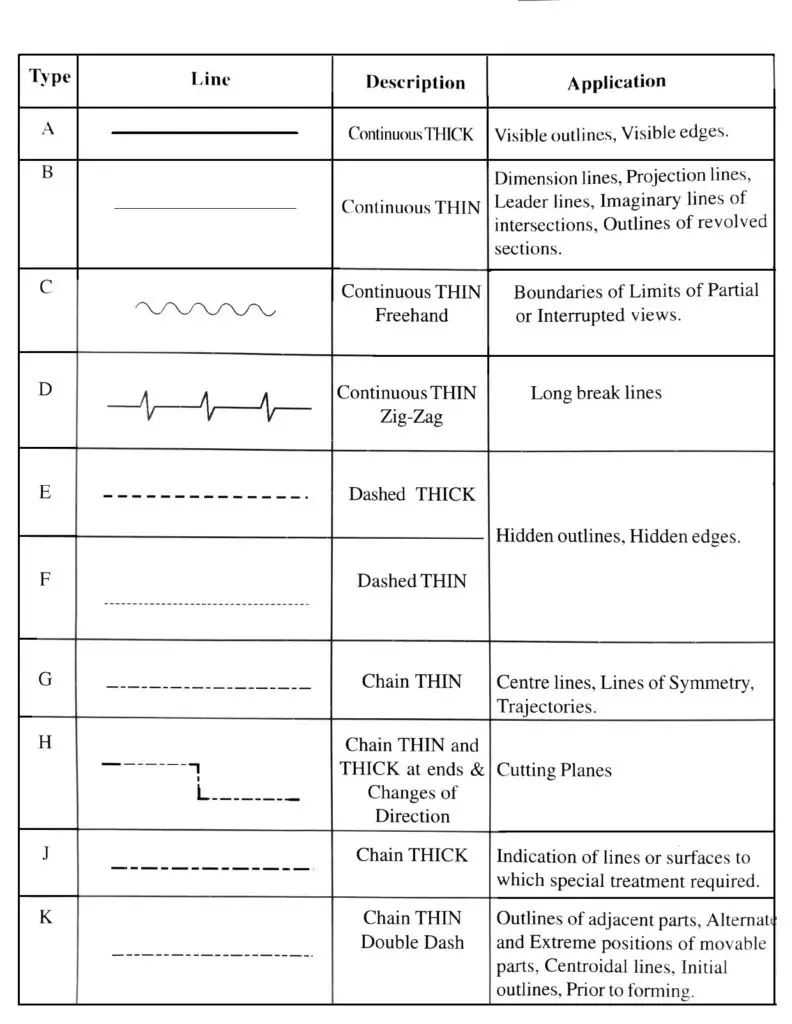
For general engineering drawings, the types of lines recommended by the Bureau of Indian Standards shown in Table 2 must be used. The thickness of the lines must be chosen according to the type and size of the drawing from any of the six groups given in Table 1.
In the case where other types of thickness of lines are used for special cases, for example, electrical and piping drawings, or if the lines specified in Table 2 are used for applications other than those detailed in the last column, the conventions adopted must be explained by notes on the drawing concerned.
Table 1: Thickness of lines (All dimensions in mm)

Table 2: Thickness of Lines

Outline of Parts type lines represent the visible edges of the objects, hence should be outstanding in appearance and therefore, be drawn as bold i.e., thick continuous lines.
Dimension, Projection, Leader, Hatching Lines
Dimension, Projection, Leader, and Hatching type lines must be drawn thin and continuous. The extension lines for dimensioning should run from the outlines without leaving a gap and extend beyond the dimension lines. This type is also used to draw outlines of adjacent and revolved sections.
Limits or Boundaries of Partial or Interrupted Views
Limits or Boundaries of Partial or Interrupted Views type lines are drawn as continuous, thin, wavy, freehand lines to represent limits or boundaries of partial or interrupted views.
Break Lines
Break Lines type lines are ruled, short, zig-zag thin lines drawn to represent the breaks.
Hidden Lined (Thick)
Hidden Lined (Thick) type lines consist of thick short dashes, closely and evenly spaced. These lines are drawn to represent hidden or invisible edges of the objects.
Hidden Lines (Thin)
Hidden Lines (Thin) type lines consist of thin short dashes, closely and evenly spaced. These lines are drawn to represent hidden or invisible edges of the objects. Although THICK lines of Type-E are recommended for representing the hidden edges, THIN lines of Type-F are preferred.
Centre lines, Lines of Symmetry, Trajectories, and Pitch Circles
Centre lines, Lines of Symmetry, Trajectories, and Pitch Circles type of lines are long, thin, chain lines with alternately long and short dashes of proportion ranging from 6:1 to 4:1 and evenly spaced.
The proportion once selected should be maintained throughout the drawing. The center lines are extended by a short distance beyond the outline. These lines are also drawn to represent the lines of symmetry, trajectories, and pitch circles. etc,
Cutting Plane Lines
Cutting Plane Lines are long lines, thickened ar ends and thin elsewhere, with alternately long and short dashes of proportion ranging from 4:1 to 6:1 and evenly spaced. The corners where the section plane charges the direction are made thick for a short length.
Lines to indicate Surfaces which require Additional Treatment
These are long thick lines with alternatively long and short dashes of proportion ranging from 6:1 to 4:1 and evenly spaced. These lines are drawn to indicate surfaces, to receive additional treatment like anodizing, plating, etc.
Lines to indicate Outlines of Adjacent parts, Extreme positions of Movable Parts, Centroidal lines, Parts situated in front of the Cutting Planes, Initial outlines before forming.
These are thin lines with a long and two short dashes alternately and evenly placed in a proportion ranging from 6:1 to 4:1. These lines are used to represent the outlines of adjacent parts, extreme positions of movable parts in the assembly drawings, parts situated in front of the cutting planes, initial outlines before forming, centroidal lines, etc.
That’s it. Thanks for reading. I hope I have covered everything about the “Types of Lines” It would be helpful if you could let me know if there was anything I missed or if you have any doubts about anything I wrote.
Please share this article with your friends if you find it interesting.
Want free PDFs direct to your inbox? Then subscribe to our newsletter.
Download PDF of this article